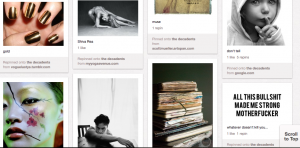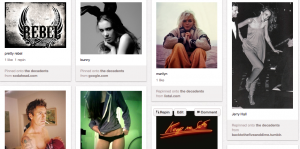why Pinterest is totally not a waste of time: creating a visionboard for your novel ( + why it's helpful)
1
I joined Pinterest for one major reason. I am returning to my novel-in-progress THE DECADENTS after a couple months' break from it and wanted to create a digital visionboard to help drive it to completion.
This book has been tricky for me because it deals with some challenging subject matter. It's also drawing on some raw life material from my years in LA which (it turns out) I'm still processing.
It's a big departure from my three previously published novels, which I regard as the work of a much younger writer: someone who was still finding her way to her true voice, who hadn't yet realized the Big Themes of her life – and thus her fiction. I'm not the same person I was back then, and I'm not the same writer. (I like to think I've deepened with age.) I've also lost a lot of illusions, which means that the personal world I am writing both from and about is very different. And some of those changes, I realize now, still had to settle into me before I was equipped to write the novel that I need to write.
But I digress. (Clears throat.) So.
Pinterest.
Visionboard.
Yeah.
I've always – always – written to music, and I create playlists for each novel (and for some of the characters) to serve as a private soundtrack. My brain learns to associate certain songs with a certain kind of fiction writing – neurons that fire together, wire together – so when I sit at my desk and start up iTunes on my Mac, my brain realizes it's Bidness Time and shifts into the required state. (This is why creative rituals can be so effective – once they're ingrained, they can shortcut you into productivity. )
Not to mention — music inspires, even without the power of ritual.
Music gets you in the mood.
So why not do this visually?
Marketers have realized that the more senses a brand can evoke, the more powerful the connection it can form with the consumer. It makes sense to apply this to the creative process. The more senses you engage as you bring your work into being, the more vivid and committed the relationship you form with it – which ends up creating a more powerful experience for your audience.
2
In his book BLAH BLAH BLAH: WHAT TO DO WHEN WORDS DON'T WORK, Dan Roam compares our visual and verbal minds.
Our visual mind, he says, is a hummingbird.
Our verbal mind is a fox. (How cute.)
The fox is:
Linear
Analytical
Patient
Clever
(A little smug)
The fox "advances step by step with laser-like focus." He shifts as he needs to but keeps his eyes straight ahead. He "tests the wind, calculates distance and velocities, and, at the precise moment…he strikes!"
And then he's very impressed with himself.
The hummingbird is:
Spatial
Spontaneous
Synthesizing
(flighty and easily distracted)
The hummingbird "sees clearly in all directions at all times…She sees her environment as a three-dimensional space with food potential everywhere; she can fly backward (and even upside down) to get to the nearest flower." She's so speedy that she doesn't have to get from point to logical point like the fox; she just appears where she wants to be. And she synthesizes: "touching and seeing everything, she builds a complete model of the forest in her mind."
And then she wonders where she put her keys.
The verbal mind is the "piece-by-piece" fox mind. The visual mind is the "all at once" hummingbird mind. The fox is the trees; the hummingbird is the forest.
I wanted, in writing my novel, a little less fox and a little more hummingbird. I felt like I was losing the forest for the trees, and getting trapped in thickets. Which is one reason I decided to cultivate the visual side of my brain.
By creating a visionboard, I am 'telling' the story of my novel….all at once. I can get a kind of deep visceral feeling for how the different parts relate to each other, and flash on some new insights as a bonus.
3
A visionboard acts as a creative trigger in other ways as well:
a) It sends you on a hunt for appropriate images. Since images, like music, evoke mood and feeling, you not only have to think about the look of your novel, but how it should make you feel.
(When I come across images that I like, and want to keep, but that don't feel right for my visionboard, I use the 'like' button to tag them and store them away for whatever.)
Which means you define the general aesthetic of your novel by what you reject as much as — if not more than — what you select. As I do this, my vision for the novel assumes greater depth and clarity.
And for any vision to be compelling, it needs to be clear. A strong, clear vision that resonates with you emotionally can act like a kind of motivational tractor beam. It pulls you along. It pulls you in. Which means you're more likely to achieve your goal – or finish the novel.
b) As you search out images, you are also feeding your head.
There's a great quote by Gertrude Stein: Everything must come into your scheme, otherwise you cannot achieve real simplicity.
When you open yourself up to different kinds of influence, you are priming your creative pump. The mind is a restless, pattern-making machine: and, like a shark, it must be constantly on the move. Which means it's constantly digesting what you feed it: seeking out new connections and relationships that incorporate this new material into whatever pre-existing scheme you might be working with.
So by discovering images that symbolize your old ideas….you'll also find images that help you produce new ideas (or tweak the old ones in new ways).
c) Like any other form of social media, Pinterest can be addictive. But if used with intention and timing, it can also help your writing because of how it allows you to take a break from it.
Thoughts create neural pathways in the brain. When those thoughts repeat, those pathways deepen. We get blocked in our creative work when we get trapped in the same loops of thinking and cut ourselves off from the kind of stimulation that can trigger new ideas (see above).
In the book THE BREAKOUT PRINCIPLE, Harvard professor Herbert Benson refers to
"a powerful mind-body impulse that severs prior mental patterns and…opens an inner door to a host of personal benefits"
including an increase in creative insight.
In sum, the way to achieve this is by working a problem as hard as you can until you hit that inner wall and cannot get beyond it. Then you remove yourself to a completely different kind of activity that lulls you into a kind of trance. Random thoughts might drift through your mind….and then, without warning, some kind of solution bursts forth.
(Benson talks about "the relaxation response, which measured cardiovascular and respiratory responses", etc., and how the science of that underpins the breakout principle, but excuse me if I don't get into all that. I'm going for the really general gist of it.)
Switching from your writing to Pinterest can also serve to switch off those repeating thought-loops that weren't getting you anywhere. By immersing yourself in a different activity – one which allows your mind to relax and roam – you're setting yourself up to kick some more creative ass.
4
As always, intention is important. Stating your intention at the beginning of any endeavor sends a signal to your unconscious mind to bring certain things to your attention while ignoring what's not relevant.
To that end, you could create a "vision statement" for your board – and your novel – that keeps you focused and on track. You could come up with what Joyce Schwarz in her book THE VISION BOARD refers to as a "power word" that serves a both a "vision statement and defining image" for what you want your board to accomplish. It could be a word or words that states the general theme of your project, or the end result you want to create, or a feeling you want to invoke in the audience, or…anything, really.
After all, it's your visionboard.
5
Do you work with visionboards? Do you have any thoughts on them or experiences to share in the comments below?
If you're on Pinterest, and especially if you're creating a visionboard of your own, look for me.
Maybe we can inspire each other.










